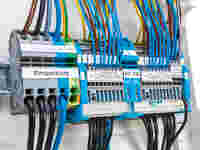Example 1: Unlimited Commoning
WAGO’s 2002 Series Continuous Jumpers readily connect an unlimited number of terminal blocks to each other. The jumpers are designed so that a contact for two jumpers can be placed in one jumper slot, providing a common contact. This means that only one jumper slot of the TOPJOB® S Rail-Mount Terminal Blocks is required for continuous commoning. The second jumper slot can be used for additional commoning, accommodating TOPJOB® S Connectors for additional connections or for testing. For any additional function, or commoning a greater number of terminal blocks during commissioning, simply add another continuous jumper. Removing individual jumpers from the assembly is just as easy. This way, you can common any number of terminal blocks with a single product.
Yet another advantage is that continuous jumpers can be used to common any number of terminal block function groups. Only one jumper is needed to connect 2, 3, 4 or “n” terminal blocks. Here too, changes can be made flexibly.
Example 2: Commoning via Step-Down Jumpers and Push-in Type Jumper Bars
One WAGO Pro Power Supply with 24 V powers several loads, in this case eight, through a single electronic fuse. The loads’ neutral conductors are connected to the blue TOPJOB® S Neutral Conductor Terminal Blocks. In this example, two four-conductor Series 2001 Terminal Blocks are used. A two-conductor TOPJOB® S 2004 Series Rail-Mount Terminal Block is used to link the loads’ negative poles to a power supply.
The 2001 Series (nominal cross-section: 1.5 mm2/16 AWG) and the 2004 Series (nominal cross-section: 4 mm2/12 AWG), which is two cross-sections larger, can be commoned with a standard 2001 Series 3-Way Push-in Type Jumper Bar (Item No. 2001-403). The last jumper contact can be inserted into the jumper slot of the 2004 Series. Commoning over the end plate is also possible.
Therefore, the TOPJOB® S Rail-Mount Terminal Block system allows terminal blocks differing by up to two nominal cross-sectional sizes to be commoned using a simple push-in jumper bar from the smaller series. Nonetheless, it is important that the total current of the outgoing circuits not exceed the nominal current of the push-in type jumper bar.
WAGO’s TOPJOB® S jumper line also offers the right solution for all other commoning tasks. Star and delta jumpers are available for star or delta motor connections. Pluggable vertical jumpers can easily connect all the levels within multilevel terminal blocks. Staggered jumpers allow you to accommodate four potentials alongside each other. Potentials with different spacing and heights can also be easily commoned using push-in type wire jumpers.




